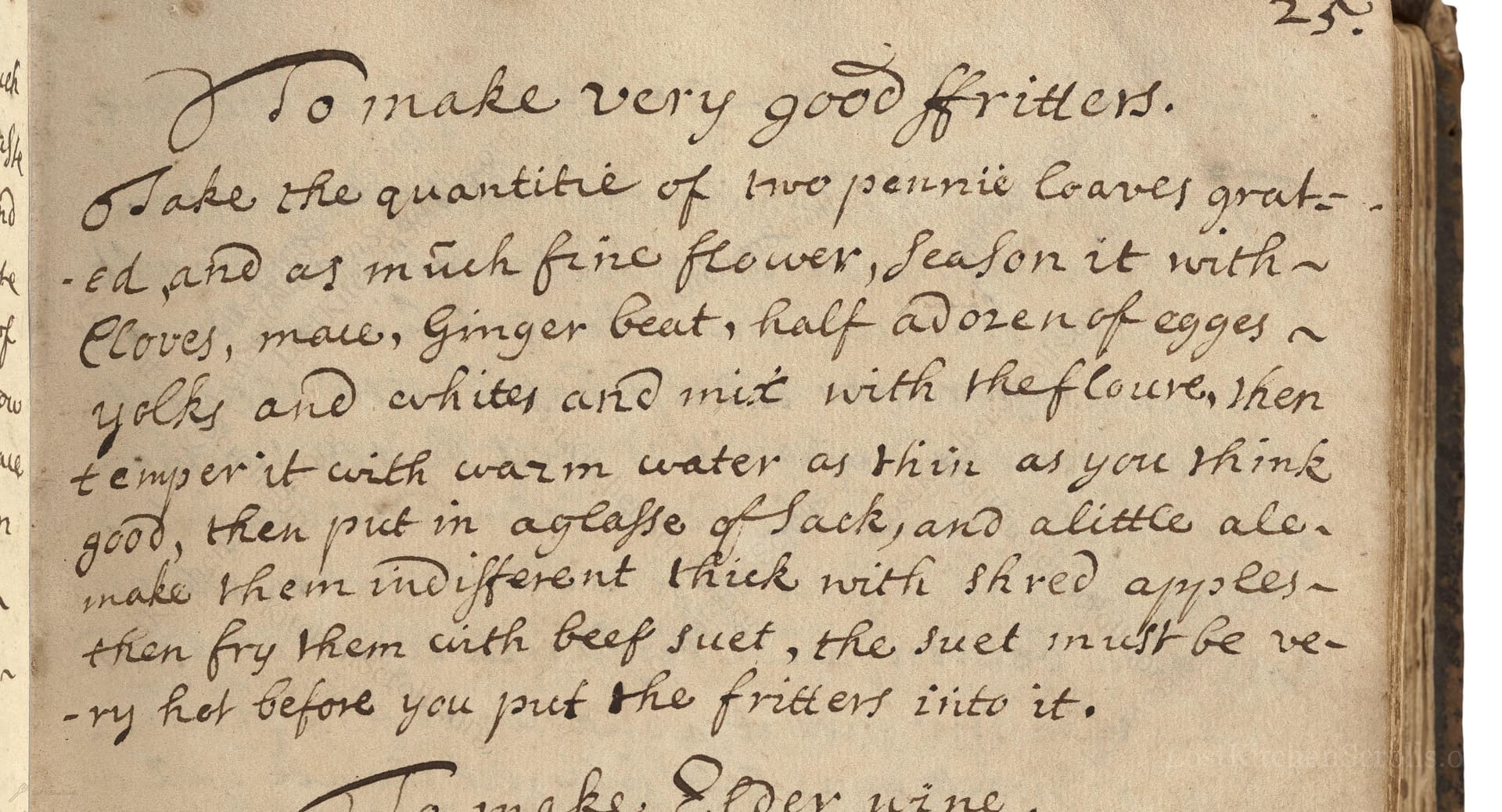To Make Very Good Fritters
From the treasured pages of Cookbook
Unknown Author

To Make Very Good Fritters
"Take the quantitie of two pennie loaves grated and as much fine flower, season it with ~ Cloves, mace, Ginger beat, half a dozen of egges ~ yolks and whites and mix with the floure, then temper it with warm water as thin as you think good, then put in aglasse of Sack, and a little ale. make them indifferent thick with shred apples ~ then fry them with beef suet, the suet must be very hot before you put the fritters into it."
Note on the Original Text
This recipe is written in the brief, conversational style typical of early 18th-century household manuscripts. Quantities are approximate, relying on visual cues and the experienced hand of the cook; standard measures (like modern grams or cups) were not used. Spices are noted as 'beat', meaning ground. 'Sack' refers to a now-archaic term for sherry. 'Floure' is simply flour. 'Beef suet' is clarified beef fat, essential for achieving a crisp finish. These recipes assume familiarity with basic kitchen processes and are meant to guide, not dictate.

Title
Cookbook (1706)
You can also click the book image above to peruse the original tome
Writer
Unknown
Era
1706
Publisher
Unknown
Background
Step back to the early 18th century with this charming culinary collection, brimming with period recipes that tantalize the tastebuds and offer a delicious glimpse into historic kitchens.
Kindly made available by
Folger Shakespeare Library
This fritter recipe is drawn from an English household manuscript dating to around 1706. It represents the resourceful, celebratory cookery of early 18th-century England, blending leftover bread with accessible spices and apples—a staple ingredient. The inclusion of sack (a sweet fortified wine) and ale nods to festive occasions and the rich flavor palate of the time. At the heart, these homey fritters reflect both economy and indulgence, turning modest kitchen staples into something fit for a special table.

The recipe would have been mixed in a large wooden or earthenware bowl using a wooden spoon or bare hands. Bread would be grated on a simple hand grater. Fritters were fried in a large iron or brass pan set over a hearth or open fire, using rendered suet as the frying medium. Tongs or a slotted spoon might have been used to turn and retrieve the cooked fritters.
Prep Time
20 mins
Cook Time
25 mins
Servings
12
We've done our best to adapt this historical recipe for modern kitchens, but some details may still need refinement. We warmly welcome feedback from fellow cooks and culinary historians — your insights support the entire community!
Ingredients
- 7 oz grated stale white bread (about 2 small rolls)
- 7 oz plain flour
- 1/4 tsp ground cloves
- 1/4 tsp ground mace
- 1/2 tsp ground ginger
- 6 large eggs
- 7 fl oz warm water (approximate; adjust for batter consistency)
- 2 fl oz sweet sherry (substitute for sack)
- 2 fl oz mild ale
- 2 medium apples, peeled, cored, and finely chopped
- 7 oz beef suet or rendered beef fat (substitute: vegetable shortening for vegetarians)
Instructions
- Begin by finely grating about 7 oz of slightly stale white bread (the equivalent of two small rolls).
- Combine this with 7 oz of plain white flour in a mixing bowl.
- Add a good pinch each of ground cloves, mace, and ginger—don't skimp, as these are the heart of the flavor.
- Crack six large eggs into the mixture, using both yolks and whites.
- Gradually blend in enough warm water (about 7 fl oz) to create a batter that is thick but pourable, rather like pancake batter.
- Pour in 2 fl oz of sweet sherry (as a stand-in for sack) and a splash (about 2 fl oz) of mild ale.
- Peel, core, and finely chop 2 medium apples and fold them into the batter.
- Now, heat 7 oz of beef suet (or rendered beef fat) in a deep pan until very hot.
- Drop spoonfuls of the mixture into the suet, frying each fritter until golden and crisp.
- Serve them hot, perhaps dusted with a bit of sugar, as was the fashion.
Estimated Calories
215 per serving
Cooking Estimates
It takes about 20 minutes to prepare and mix the ingredients. Cooking the fritters in batches takes about 25 minutes. Each fritter is about 215 calories if you make 12 fritters from this recipe.
As noted above, we have made our best effort to translate and adapt this historical recipe for modern kitchens, taking into account ingredients nowadays, cooking techniques, measurements, and so on. However, historical recipes often contain assumptions that require interpretation.
We'd love for anyone to help improve these adaptations. Community contributions are highly welcome. If you have suggestions, corrections, or cooking tips based on your experience with this recipe, please share them below.
Join the Discussion
Rate This Recipe
Dietary Preference
Culinary Technique
Occasions

Den Bockfisch In Einer Fleisch Suppen Zu Kochen
This recipe hails from a German manuscript cookbook compiled in 1696, a time whe...

Die Grieß Nudlen Zumachen
This recipe comes from a rather mysterious manuscript cookbook, penned anonymous...

Ein Boudain
This recipe comes from an anonymous German-language manuscript cookbook from 169...

Ein Gesaltzen Citroni
This recipe, dating from 1696, comes from an extensive anonymous German cookbook...
Browse our complete collection of time-honored recipes



